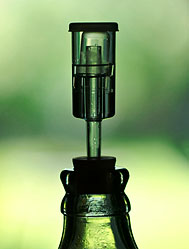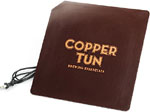 During the 2nd racking of the juice. I have had my Senior Air-Lock sometimes just stop working. What cause’s this? I use water in my Air-Lock’s.
During the 2nd racking of the juice. I have had my Senior Air-Lock sometimes just stop working. What cause’s this? I use water in my Air-Lock’s.
Name: Linda H.
State: Nevada
—–
Hello Linda,
I believe what you are saying is that your wine air-lock stops bubbling, then starts up again. There could be a number of reasons for this, but by far the most likely reason is a temperature change of the wine must.
In order for a wine yeast to ferment it needs to be in a particular temperature range. Most wine yeast feel comfortable at 70° to 75° F. Fermentations that are cooler than this become slow and will even stop completely if too cold. For some wine yeast they can even completely stop bubbling at temperatures of 67° or 68° F.
The difference of the rate of fermentation between 70° and 75° can even be quite dramatic. It can mean the difference of an air-lock that bubbles once a minute or once a second.
So what I believe is happening to your fermentation is that the temperature is fluctuating. When the weather gets cooler and the ambient room temperature gets a little cooler, the fermentation slows down, crawls and then stops. When a spot of warmth comes along, the fermentation temperature rises and the fermentation takes off again.
This begs the question of what you are to do when your air-lock stops bubbling. Obviously, you need to stabilize the temperature of the fermentation, but how? The simplest solution is to provide a heat source to the fermenter. This can be done in a number of ways. The important thing to remember is to make it a mild heat source. It is easy to overdo it, which can be just as bad. Having a fermentation too warm could lead to even worse problems such as mold or bacterial growth.
- I have found that over the years that if an older-style, 100 watt light bulb is place 1 foot off to the side of a 5 or 6 gallon batch of wine, it will warm it up 8° to 10° F. depending on how cold the room is. You can place if farther away or closer for varying effect. What you do have to watch out for with this method is exposing the fermenting wine to the direct light from the light bulb. Excessive light exposure can oxidize the wine over time, so make sure that it is an opaque fermenter or block the light in some fashion.
- I have not done this, but I have heard of people using an electric blanket to warm up the fermentation. The problem with electric blankets is that they are way, way too hot. But you could conceivably take a corner of one, on a low setting, and stick it under part of the fermenter. The big issue here is that you don’t know how much of the electric blanket to use, so the risk of getting the fermentation too warm is very real. I definitely would not try this without having a thermometer directly tracking the wine must’s temperature.
 Fortunately, these days there is a product designed specifically for this purpose. It’s called the Copper Tun Heating Pad. Just like the name sounds, it is a pad that you sit the fermenter on to keep it from getting cold. The heating pad will raise the temperature of the wine must between 10° and 20° F. Since this item has came out, I do not use anything else. It is simple to use and effective.
Fortunately, these days there is a product designed specifically for this purpose. It’s called the Copper Tun Heating Pad. Just like the name sounds, it is a pad that you sit the fermenter on to keep it from getting cold. The heating pad will raise the temperature of the wine must between 10° and 20° F. Since this item has came out, I do not use anything else. It is simple to use and effective.
Beyond these methods remember that you always have the option of moving the fermenter to a warmer room or corner of your home. This is often the simplest action to take when your air-lock stops bubbling.
Happy Winemaking,
Ed Kraus
———————————————————————————————————
Ed Kraus is a 3rd generation home brewer/winemaker and has been an owner of E. C. Kraus since 1999. He has been helping individuals make better wine and beer for over 25 years.

I have had a similar issue. I found that if I don’t have a good seal the gases bypass the air lock. This happens often with the plastic primary fermenter (from you). I find the screw on lid really needs to be TIGHT to get a good seal. I also had this with a carboy and an older stopper.